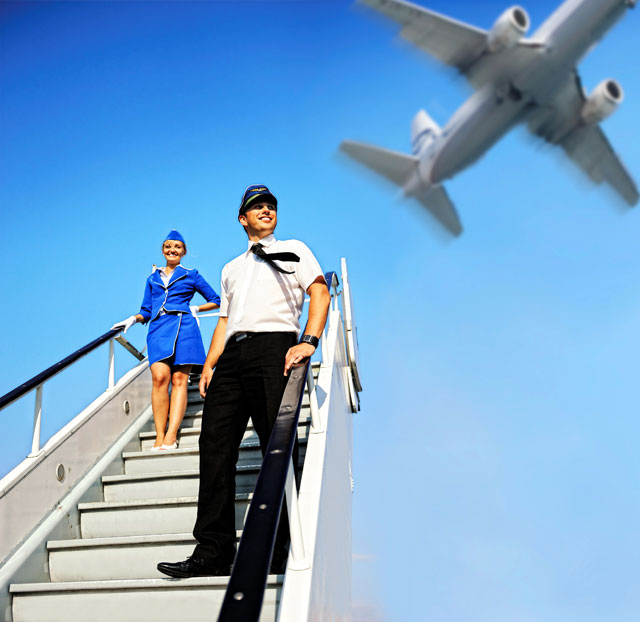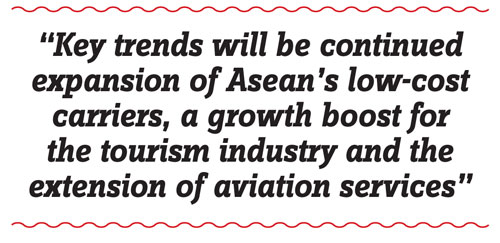The liberalisation of Southeast Asia’s aviation sector will be a major catalyst for
the region’s economic growth to 2030
By Rajiv Biswas
Asean’s airlines are poised for rapid expansion over the next two decades as they take delivery of an estimated 3,000 new commercial aircraft by 2032, which represents a market of about $500 billion for aircraft manufacturers. Key trends during this period will be continued expansion of Asean’s low-cost carriers, a growth boost for the region’s tourism industry and the extension of aviation services such as maintenance and overhaul.
The creation of the Asean Single Aviation Market (ASAM) is a key part of the roadmap for the establishment of the Asean Economic Community (AEC) in 2015. The region’s governments have recognised the importance of air transport for economic development and have designated the industry as one of twelve priority areas in the establishment of the AEC.

Asean’s member states concluded several multilateral agreements that will provide key building blocks for the creation of a single commercial aviation market.
The agreements, to be implemented next year, will significantly liberalise the region’s aviation market for airlines flying between designated international airports in Asean member countries. In addition, the ownership limits for shareholders from other Asean countries in Southeast Asia’s airlines will increase to 70%, and there will be free movement of skilled aerospace industry workers such as pilots and aerospace engineers, within the region.
The opening up of Southeast Asia’s skies will help to increase competition on major routes between the region’s international airports, helping to constrain airfares for consumers and boosting air passenger traffic. The increased competition, combined with higher ownership limits for Asean shareholders, will also support further consolidation in the airline industry.
The total fleet size of Asean airlines is projected to triple between 2012 and 2032 from 1,110 to 3,490 aircrafts, according to the latest forecasts by Boeing. The company also expects that low-cost carriers (LCC) will continue to increase their market share over the next two decades, with their portion of total available seat kilometres forecast to increase from the current 22% to 42% by 2032.
The strong growth of LCCs was also reflected in the Singapore Airshow in February: Vietnam’s VietJetAir placed an order for 63 Airbus jets with an option for an additional 30, while Thailand’s Nok Air committed to buying 15 Boeing jets. Myanmar Airways signed a deal to lease 10 new Boeing jets.

Rapid fleet growth and domestic and international passenger traffic will also drive a boom in Asean’s aerospace industry, particularly in the maintenance, repair and overhaul (MRO) sector.
Singapore is particularly well positioned to benefit from this trend. The city-state is currently the leading hub for MRO in Asia – accounting for an estimated 25% of the market – and will be a key beneficiary of fast growth over the next two decades.
Malaysia is another important MRO hub in the Asia-Pacific, with the Malaysian government’s Economic Transformation Programme having focused on these services as a key industry for future growth of value-added output and employment.
In particular the quick expansion of Malaysia’s AirAsia, the largest low-cost carrier in the region, boosted the development of Malaysia’s MRO market, which is estimated at $2 billion.
By 2020, the sector’s sales revenues are projected to double, according to the Malaysian government.
In Indonesia, Lion Air this year established its own MRO centre, Batam Aero Technic, at Hang Nadim International Airport in Batam.
Although Asean has taken crucial steps towards liberalisation of its air transport industry, further reforms are still needed to tap the potential economic benefits from the aviation industry.
There are a number of key priorities: Firstly, the liberalisation of Asean skies needs to be extended to domestic routes, encouraging greater competition in the domestic market, which will help to limit airfares, accelerate the growth of domestic air passenger numbers and increase the choice of services available for passengers.
Secondly, the development of new airports and modernisation of existing airports will be a key task for Asean, in order to provide high-quality airport infrastructure to cope with rapidly rising air passenger traffic numbers on domestic and international flights. This is also critical for fostering the region’s tourism sector.
Singapore, Malaysia and Thailand are already global leaders in developing world-class international airports. Changi Airport was voted the world’s best airport in 2013 at the Skytrax World Airport Awards, with a current capacity of 66 million passengers. It is planned to increase its capacity to 135 million passengers by 2025. Kuala Lumpur also ranks among the top ten airports in the Asia-Pacific.
Others are set to follow: Myanmar’s government plans the construction of a new international airport near Yangon in order to cope with a boom in international tourist visits and Indonesia is modernising its airports in Bali and Jakarta.
Thirdly, the development of an adequate supply of skilled aerospace industry staff is a critical requirement for the Asean aerospace industry, in order to match the human capital needs of the aviation industry for pilots, engineers and technicians.
For example, the Indonesian MRO sector is forecast to grow 10% annually over the next decade, according to projections by GMF AeroAsia, Indonesia’s largest MRO operator. However, due to shortages of skilled workers, Indonesian airlines still need to outsource much of their work.
The surge in the number of middle-class households in emerging Asia is projected to support continued strong growth in tourism flows to Asean over the next 10 years, with Southeast Asia forecast to be one of the world’s fastest growing tourism markets over the next two decades.
Against this backdrop, Southeast Asia’s governments will need to pursue large-scale capacity expansion programmes and upgrading of Asean’s airport infrastructure if they want to reap the benefits of a fast-growing intra-Asian tourism industry.


